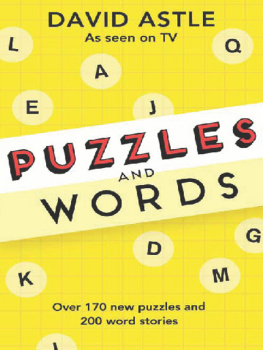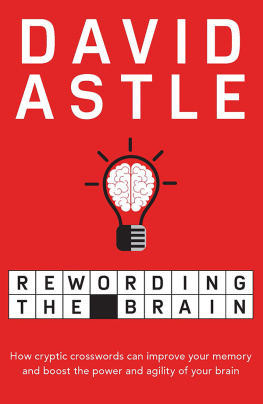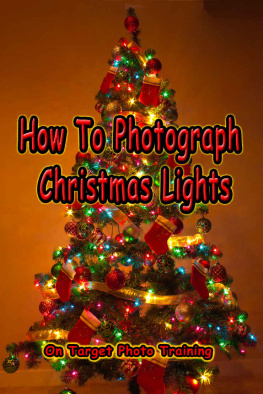


Over 170 new puzzles and
200 word stories
DAVID ASTLE

First published in 2012
Copyright David Astle 2012
All rights reserved. No part of this book may be reproduced or transmitted in any form or by any means, electronic or mechanical, including photocopying, recording or by any information storage and retrieval system, without prior permission in writing from the publisher. The Australian Copyright Act 1968 (the Act) allows a maximum of one chapter or 10 per cent of this book, whichever is the greater, to be photocopied by any educational institution for its educational purposes provided that the educational institution (or body that administers it) has given a remuneration notice to Copyright Agency Limited (CAL) under the Act.
Fairfax Books, an imprint of
Allen & Unwin
Sydney, Melbourne, Auckland, London
83 Alexander Street
Crows Nest NSW 2065
Australia
| Phone: | (61 2) 8425 0100 |
| Email: | info@allenandunwin.com |
| Web: | www.allenandunwin.com |
Cataloguing-in-Publication details are available
from the National Library of Australia
www.trove.nla.gov.au
ISBN 978 1 74331 103 5
Internal design by Kirby Stalgis
Set in 11/14.5 Avenir Pro by Bookhouse, Sydney
Printed in Australia by McPhersons Printing Group
10 9 8 7 6 5 4 3 2 1

For the viewers and the solvers
CONTENTS
Within these pages lurk moofers and splogs, fuds and fids, Parwill and vishing: strange words you have probably never met before. Then there are familiar words with peculiar stories, like dugong and Google, manure and peculiar.
Youll also meet Miss Muffet and Billy Blanks, and get to dabble in fencing and a game called oichokabu. And thats just a few nibbles of the 200-plus stories inside, covering everything from abracadabra to zzxjoanw (a Maori drum that doesnt exist).
As a bonus, every dip into the dictionary comes with a set of puzzles related to the topic. So the Full Monty story is followed by a movie riddle and a striptease anagram. Or after a page of sailor slang, you get to splice words like old-time rigging.
To help you navigate, each puzzle is graded from one hourglass (breezy) to three (brain-busting), while this symbol suggests a bit of both. The Macquarie Dictionary serves as umpire when it comes to what words are okay. Its also important to note that some puzzles, often those involving puns or word chases may well have more than one solution.
Answers are in the back, if you cant resist peeking. To borrow from Lisa Simpson (page 22), have a cromulent time with Puzzles and Words.
Lets toy with two toys that both rely on blocks. The first is a global craze that goes by the name of LEGO. At some stage, every kid has played with these tiny bricks, building a city, a fairy palace, a pirate ship. Each vivid plastic block has bumps (or nodes) designed to interlock.
A Danish carpenter called Ole Kirk Christiansen dreamt up the idea in 1954. The name Lego echoes the Danish phrase Leg godt, or play well. Its a lovely fluke when you consider that lego is also Latin for I collectsurely what most parents end up saying as they gather the pieces after playtime.
Our second game has more to do with destruction than construction. Yet, strangely, JENGA arises from a Swahili word meaning to build. The game was created by a Tanzanian-born Brit named Leslie Scott, and launched in the 1980s.
To win at Jenga you need to pull out the wooden blocks from a rickety tower, piece by piece, without the whole thing toppling over. Chaos often follows, as hinted at by Jengas other names around the world. Israelis know the game as Mapolet, or avalanche. Danes prefer Klodsmajor, alias klutz. In Rio, meanwhile, the challenge is called Torremoto, a play on words meaning tower-quake.
 1. LEGO is a jumble of OGLE (meaning to look at wolfishly). Can you look at these eight other words for look (or looks), and scramble each one to make a total of 15 words, where every letter is used once only?
1. LEGO is a jumble of OGLE (meaning to look at wolfishly). Can you look at these eight other words for look (or looks), and scramble each one to make a total of 15 words, where every letter is used once only?

 2. Squeeze a T into LEGO and you spell LET GO. Now do the same with the clues below, adding a T to the first answer to reveal the second.
2. Squeeze a T into LEGO and you spell LET GO. Now do the same with the clues below, adding a T to the first answer to reveal the second.
(a) droop/male deer (3/4) _ _ _ / _ _ _ _
(b) run off/naval unit (4/5) _ _ _ _ / _ _ _ _ _
(c) decreasing/desiring (6/7)
_ _ _ _ _ _ / _ _ _ _ _ _ _
(d) out of practice/reliable (5/6)
_ _ _ _ _ / _ _ _ _ _ _
(e) showy shells/pens together (7/2-6)
_ _ _ _ _ _ _ / _ _- _ _ _ _ _ _
(f) went zzz?/went harrumph? (6/7)
_ _ _ _ _ _ / _ _ _ _ _ _ _
(g) educates/packing box (7/3,5)
_ _ _ _ _ _ _ / _ _ _ _ _ _ _ _
(h) hospital operator/fish (7/8)
_ _ _ _ _ _ _ / _ _ _ _ _ _ _ _
Water has timeless links to information. These days, office workers hear murmurs at the WATER COOLER, or maybe after work, drinking at the local WATERING HOLE. Long ago the rumour mill was the PARISH PUMP, where villagers would chat as they collected the days supply.
FURPHY is a great Australian word for a false story. No word of a lie, this term stretches back to World War I when diggers in Egypt and Palestine milled around a water cart to drink and washand, presumably, tell tall tales. The cart was called a furphy after its inventor, blacksmith John Furphy from Shepparton, Victoria.
The word SCUTTLEBUTT has similar origins. In this case the idle gossip arose from a drinking cask (or butt) aboard a sailing ship. The barrel had a hatched hole (or scuttle, from Spanish escotar, to cut out), allowing sailors to dip their ladles.
And to disprove the notion that watery words only offer dubious news, we finish our story in the Islamic world. To lead pure lives, Muslims obey SHARIA LAW, a set of rules founded on the Koran. The water link? Sharia is Arabic for the path to the well, where the holy word of Allah is viewed as the believers fountainhead.
 1. Ironically, what succulent salt-water crustaceans swim in the letters of SPRING WATER? Every letter is used once only.
1. Ironically, what succulent salt-water crustaceans swim in the letters of SPRING WATER? Every letter is used once only.
_ _ _ _ _ / _ _ _ _ _ _
 2. MOUTH-WATERING contains all five vowels once, as does CARRIED OUT. Supplied below are the first halves of nine more such terms, where every vowel appears once only. See if you can figure out the second word. (The number in brackets shows the omitted words length.)
2. MOUTH-WATERING contains all five vowels once, as does CARRIED OUT. Supplied below are the first halves of nine more such terms, where every vowel appears once only. See if you can figure out the second word. (The number in brackets shows the omitted words length.)
Next page


















 1. LEGO is a jumble of OGLE (meaning to look at wolfishly). Can you look at these eight other words for look (or looks), and scramble each one to make a total of 15 words, where every letter is used once only?
1. LEGO is a jumble of OGLE (meaning to look at wolfishly). Can you look at these eight other words for look (or looks), and scramble each one to make a total of 15 words, where every letter is used once only?
 2. Squeeze a T into LEGO and you spell LET GO. Now do the same with the clues below, adding a T to the first answer to reveal the second.
2. Squeeze a T into LEGO and you spell LET GO. Now do the same with the clues below, adding a T to the first answer to reveal the second. 2. MOUTH-WATERING contains all five vowels once, as does CARRIED OUT. Supplied below are the first halves of nine more such terms, where every vowel appears once only. See if you can figure out the second word. (The number in brackets shows the omitted words length.)
2. MOUTH-WATERING contains all five vowels once, as does CARRIED OUT. Supplied below are the first halves of nine more such terms, where every vowel appears once only. See if you can figure out the second word. (The number in brackets shows the omitted words length.)